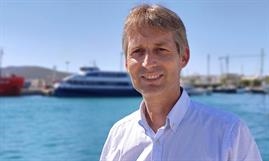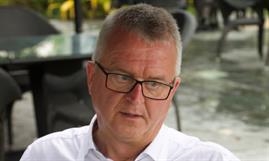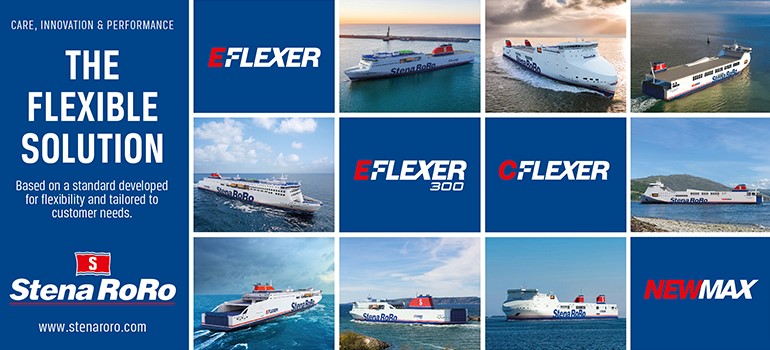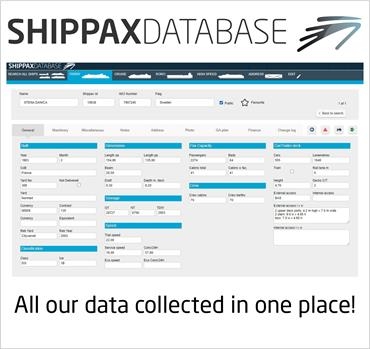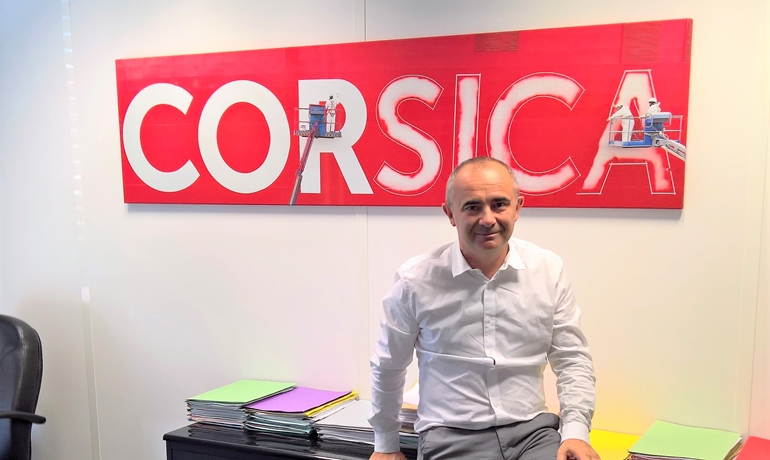
Pierre-Antoine Villanova © Nikias Ioannidis
ON BRAND IDENTITY, STRATEGIES, AND PERFORMANCE – A CONVERSATION WITH PIERRE-ANTOINE VILLANOVA OF CORSICA LINEA
InterviewIn a relatively short period of three years, Corsica Linea has established itself as a formidable brand in the Mediterranean ferry market. In mid-July, its managing director, Pierre-Antoine Villanova, shared with Shippax the reasons behind its success and his vision for the future.
As a reincarnation of SNCM, in many ways Corsica Linea still bears more than just the hallmark of its previous existence: apart from having inherited the fleet, more than 800 of its current staff are former SNCM employees.
Corsica Linea is today a totally new company that occupies a prominent freight market leadership position. It is under the full control of CM Holding, an entity that has more than 120 shareholders – most of them Corsicans.
DEVELOPING IDENTITY
Corsica Linea is a new brand in the Mediterranean ferry market. While still striving to break free from its former self and create its own identity, it has already become a well-established and well-received service provider.
It has an ambition to be a modern company. Toward this goal, as well as growing its business, it endeavours to garner trusts from both employees and customers, while trying to be a local operator with social responsibility and environmental protection in mind.
Shippax: Corsica Linea is the main freight carrier to and from Corsica. This gives you a good overview of the Corsican economy. How well is your business doing now?
Pierre-Antoine Villanova (PAV): Corsican economy had two very strong years in 2017 and 2018, driven by large construction projects and tourism. Bookings for 2019 seem to be on par with last year. We do not expect a big improvement this year. The local, non-tourism related demand is growing slowly every year. More people are relocating to Corsica. The overall picture is good.
Shippax: How have your customers responded and accepted the new brand on this traditional market?
PAV: Very well. Very few people believed in us three years ago. But now Corsica Linea is perceived as one of the best choices of travel to and from Corsica. We create confidence and trust.
Shippax: The new name also came with a brand-new eye-catching livery for all ships in the fleet (with the exception of the MÉDITERRANÉE, which is the only ship having kept the traditional white-themed hull) and a new website, etc. Was this a compulsory step to take?
PAV: Yes. And I also believe the sharp red and the new eye-catching livery for our ships were the best choices we’d made. It helped to show, both to the employees and customers, that Corsica Linea was a new operator, thus severing the link with SNCM. Only the names of the vessels have remained. They all reflect the Corsican identity; so there was no reason to change them.
Today our people are actually proud of being part of Corsica Linea and customers like the branding. The rising passenger volume is the best evidence of this. One of our employees recently told me: “A few years ago, I used to say that I was working in the shipping business, without mentioning the company name, now I proudly say that I work for Corsica Linea.” This is the best example of the new employee’s trust in our new company.
Shippax: What is the Corsica Linea philosophy?
PAV: Firstly, Corsica Linea is a business-oriented Corsican company; it has a strong presence in Marseille, too. The Marseille/Vitrolles area is, and will always be, the freight gateway to and from Corsica.
Our ambition is to be a modern company. Our vision of a modern company starts with having a strong focus on customers. The second key point is to care about the social impact of our business activities. We promote partnerships with local companies. We source as many as possible our supplies locally from Corsica. We want to be part of local economy and help creating a positive effect on it. Finally, we are committed to reducing our environmental footprints.
Shippax: How are you planning to reduce environmental footprints?
PAV: Reducing Corsica Linea’s environmental impact takes up more than 50% of my time. This is a central issue in our long-term vision. Our plan is based on three basic objectives: first, concerning MARPOL 2020, we are installing scrubbers on three of our ro-pax units, in addition to the VIZZAVONA, which already has scrubbers; second, we have been investing in cold-ironing systems for the same three ships, which will dramatically reduce environmental impact during their port stays; last but not least, we took the strategic decision to invest only in LNG propulsions for our new ships.
STRATEGIC THINKING
Side by side with the task of building a new company, Corsica Linea has a rational fleet expansion and management programme. As it is already apparent, it invests in both new and old ships. It has a strong focus on its environmental credentials and a localised business strategy.
As a local company with extensive local connections, partnerships, and clientele, it is not surprising that Corsica Linea wins Public Ferry Service contracts. The company is committed to fulfilling its obligations to public service.
Shippax: The Corsica Linea fleet currently consists of seven vessels, including VIZZAVONA, which is on bareboat charter from Grimaldi Group. A lot of time and money have been invested. Have these investments helped reducing operational costs?
PAV: We had to. When we bought vessels we realised maintenance had not been properly carried out on them during 2014-2016. It is the shipowner’s job to take care of the assets and maintain them shipshape. We started with our two workhorses, PASCAL PAOLI and JEAN NICOLI, and extended this to the whole fleet. On top of that we decided to invest in solutions that allow us to better monitor the fuel consumption by optimising the fuel consumption. Indeed we already noticed a positive effect from these efforts.
For 2019, including the newbuild, we plan to invest EUR 180 million on our fleet, mostly on environmental footprint reduction measures.
Shippax: You also upgraded the interiors of VIZZAVONA. Does that mean Corsica Linea might acquire the vessel?
PAV: We do not know yet. We upgraded the interiors mostly in order to bring the vessel in line with the rest of the fleet, since, from October, VIZZAVONA will be serving year-round on the Marseille-Bastia route. We are very satisfied with this vessel and we’d made the right choice to bareboat charter her in 2018. What will happen next is not settled yet though.
Shippax: VIZZAVONA is not part of the current Public Ferry Service contract requirement, but it performs a once-a-week Marseille-Bastia round-trip during the summer? Why?
PAV: VIZZAVONA mostly serves Algiers or Tunis, but we do operate one round-trip to Bastia during summer months, as we’d noticed that there was an extra demand, which justified this move. Before the season starts we also position rental cars and pick them up after the summer rush, using VIZZAVONA.
Shippax: Does Corsica Linea consider expanding into other markets like Morocco and the Balearics Islands?
PAV: No, we do not. We rather focus on consolidating our current network.
Shippax: As in many other ferry markets, freight is growing faster than passenger flows in your network. Can we envisage some of your routes becoming pure ro-ro links?
PAV: No, ro-pax vessels are the most suitable assets for Corsica Linea. We currently also operate a couple of cruise ferries (DANIELLE CASANOVA and MÉDITERRANÉE). The ro-pax model is definitely the way forward for us.
Shippax: Corsica Linea has been awarded Marseille-Bastia, Marseille-Ajaccio and Marseille-L’Île-Rousse routes. How will you serve these three routes from October 2019?
PAV: PAGLIA ORBA and JEAN NICOLI will serve the Marseille-Ajaccio link; PASCAL PAOLI and VIZZAVONA will serve the Marseille-Bastia route; and MONTE D’ORO will connect Marseille with L’Île-Rousse.
Shippax: So far, you have two ships that are not part of the Public Ferry Service contract requirement. Only two ships are required for the remaining two routes. Is there a risk that part of the fleet might remain idle from October?
PAV: I can only speak for my company. It is the shipowner’s responsibility to find deployment for those ships, whatever the result of the upcoming Marseille-Propriano and Marseille-Porto-Vecchio tenders may be.
OPPORTUNISTIC PERFORMER
It can be said that Corsica Linea’s strategies have born fruits. While it continues to seek other opportunities, the company has done well since its rebirth into the current form, both in terms of business performance and market shares. The recent figures tell the story. The company is expanding on all fronts.
CORSICA LINEA KEY FIGURES
|
|
2016 |
2017 |
2018 |
|
Passengers |
468,000 |
568,000 |
650,000 |
|
Freight units |
63,200 |
71,500 |
76,000 |
|
Sailings |
1,465 |
1,600 |
1,760 |
|
Turnover (MEUR) |
170 |
200 |
220 |
Source: Corsica Linea
Shippax: Corsica Linea also operates on the Marseille-Algiers and Marseille-Tunis routes. How well have you performed on the North African market in general?
PAV: Freight volumes to Tunisia and Algeria are low. Algeria is mainly a container-oriented market and there is little room for ro-ro and ro-pax traffics. Tunisia is more interesting, but, still, the core business there remains passengers. We carried 200,000 passengers to and from Algeria and Tunisia last year. This is exactly 30% of our total passenger volume.
Shippax: This year MÉDITERRANÉE, DANIELLE CASANOVA, and VIZZAVONA serve North Africa. Next year VIZZAVONA will serve Corsica. Does that mean you will have less available capacity for Algiers and Tunis.
PAV: Do not forget that VIZZAVONA only joined the route during the summer 2018. Before that we had served this market with only two ships. We are pragmatic, opportunistic and business oriented. If we see a good opportunity, we will seize it.
Shippax: According to the ORTC (Observatoire Régional des Transports de la Corse) figures, the first half of 2019 proved to be very successful for your company, with freight volume growing by 5%, reaching 525,000 lanemetres, faster than the market in general, though you were affected by the La Mérdionale strike of 12-27 June. You keep increasing your market share. The fact that you will have two vessels on both Marseille-Bastia and Marseille-Ajaccio routes from 1 October (rather than just one on each route now) will further boost your results. What is the full-year target for 2019?
PAV: Freight-wise we have a target of achieving 1.3 million lanemetres for this year.
Shippax: The ferry industry keeps on losing passenger market shares to airlines. Is this a problem?
PAV: Well, let me first highlight that our passenger figures have been growing every year since we started this company. We will never be a leader in this segment but we are a firm believer that there will always be a market for ro-pax operations to and from Corsica. Many people enjoy short three-to-four-day stays in Corsica. For them it is a lot more practical to fly and rent a car than using the ferry.
Shippax: Many Mediterranean operators are re-introducing high-speed ro-pax services in their networks. This is particularly true in Spain and Greece. SNCM and Corsica Ferries were once frontrunners in this field with NGVs (navires à grande vitesse or high-speed craft) and ‘Corsica Express’ vessels. Do you think it could be profitable again to operate high-speed vessels between Nice and L’Île-Rousse?
PAV: I don’t think so. The distance is too big, even on the shorter Nice-L’Île-Rousse route.
LONGER VISION
A major part of Corsica Linea’s longer-term vision is firmly based on its fleet development strategy, which has so far served the company’s interests well. It is now in the process of planning a major newbuild to join its fleet.
Shippax: You’ve announced that you were planning to order an LNG-powered ro-pax newbuild in 2019. Wouldn’t it be better to wait for the result of the longer 10-year Public Ferry Service contract tender, expected in Q4 2020, before placing the order?
PAV: We think the timing is right. Ordering this new vessel perfectly matches our entrepreneurial spirit of anticipating a bright future for our company. It will allow us to better serve both our freight and passenger customers, while reducing our environmental footprints. We are actually in negotiation right now. We could order the vessel as early as in September (*). It will be a great asset for fulfilling the upcoming Public Ferry Service contract obligations, too. We also secured VIZZAVONA well ahead of the 15-month Public Ferry Service contract. We knew then that we would need this vessel. The situation is the same now.
Shippax: What about LNG bunkering? Will it be in place by the time the vessel is delivered?
PAV: The new ro-pax unit will be dual fuel. We plan to bunker LNG in Marseille and expect this to be made possible by 2022 when the new vessel joins the fleet.
Shippax: What are the main specifications of this new vessel?
PAV: She will be 206.6 metres long, with a freight capacity of 2,563 lanemetres, and featuring extra car deck capacity for 149 cars. Her service speed will be 23 knots. We will keep the passenger capacity at 650, the same as that of PASCAL PAOLI.
Shippax: Will the new vessel replace one unit of your existing fleet or will it become an addition?
PAV: This is not yet determined. We still have a lot of time before we need to make our mind up. Some of our vessels are getting old and they cannot last forever. By 2022, MONTE D’ORO will be 31 years old, for instance. So, this is definitely something we are thinking about, but for now we have not set our mind on one specific decision.
Shippax: Can we imagine a fleet standardisation for Corsica Linea, as some European ferry companies are working towards?
PAV: From a shipowner’s point of view, this would be a positive thing. But we are still a small company, compared to Stena Line, for instance. We cannot launch a newbuilding programme comparable to the E-Flexer series. I do not think this is realistic for us.
Shippax: Corsican decision makers again started to talk about building a new port in Bastia. Have you any news or view on this? Will the new port be ready in time for the new ship?
PAV: I know it is a long, on-going project. I have no more information right now. But I believe it will happen. The current port is right in the middle of the city centre. This is not convenient, neither for the freight customers nor for the city. The existing facility will not be able to absorb much more freight. So a new port is a ‘must’. Our new vessel is designed with the Bastia new port in mind.
Shippax: Three of your vessels – PAGLIA ORBA, PASCAL PAOLI, and JEAN NICOLI – will be able to connect to the port grid in Marseille by the end of 2020. What about cold ironing in Corsican ports?
PAV:We are discussing this with the port of Ajaccio right now. Regarding Bastia, we probably must wait for the new port to emerge.
(*) Not long after speaking to Shippax, at the end of July, Corsica Linea announced having placed an order for an LNG-powered, new Visentini Class ro-pax vessel for 2022 delivery. The vessel is destined for its Marseille-Corsica trade.
As a relatively small ferry operator, the company seems to punch above its weight. After three years of solid performance, the company continues to define itself. Its vision is clear: it aims to be a world-class company with a firm focus on the local market. To achieve this objective, the company strives to modernise its fleet, win market shares, and above all improve its environmental credentials.
|
CORSICAN FERRY MARKET H1 2019 Compared to the same period of the previous year, the total number of air and ferry passengers to and from Corsica has fallen by 1.1% during H1 2019. The protracted La Méridionale industrial action had a negative effect on passenger flows to and from Marseille during 12-21 June. It also affected others operators. The total sea passengers for the period reached 1,252,000, down by 4.8%, corresponding to a 42.3% market share. During this period the accumulated passenger market share for the airlines reached a record of nearly 58%. On the freight side, the overall flow has been stable, at 1,128,000 lanemetres for the six-month period. Corsica Linea increased its volume by 5%, to a record level of 525,000 lanemetres. La Méridionale’s carrying fell by 8% on account of the aforementioned strike. In June the company’s three ships carried 16,000 fewer lanemetres of cargo, compared to the figure of June 2018. Corsica Linea is the leader in this ro-ro freight market, with about 47% of the market share. At the end of its first year of operation, in 2016, this figure stood at 41%. Its competitor Corsica Ferries managed to increase its freight market share during the recent strike. It now controls about 19%. Source: Observatoire Régional des Transports de la Corse
|
sep 01 2019
Most read
MSC Cruises and Meyer Werft sign landmark agreement for up to six next-generation “New Frontier” class cruise ships
dec 15 2025


